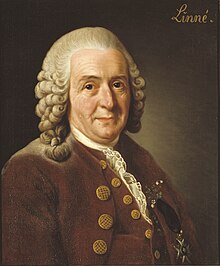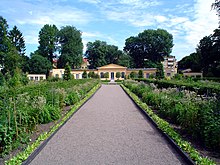
Carl Linnaeus (1707-1778, also known as Carl von Linné) was an 18th century Swedish scientist, known as the founder of modern taxonomic biology. While born near Älmhult in the province of Småland, Linnaeus spent most of his life as a professor at the university in Uppsala. He also made several scientific tours around Sweden, mapping flora and fauna of the realm. While he only left Sweden once, studying for some time in Harderwijk in the Netherlands, his apprentices ventured around the globe.
Understand
editBiography
edit

Carl Linnaeus was born on May 23 1707 in the village of Råshult, near Älmhult in Småland. Soon after his birth the family moved to the nearby village of Stenbrohult, where his father Nicolaus was a minister. Nicolaus had adopted the family name as a latinization of the Swedish word "Lind", meaning "linden tree". Linnaeus got his elementary education in Växjö, and his father originally intended him to become a priest. The town doctor had however noticed Linnaeus interest in botany, and convinced Nicolaus that Carl had a future in medicine. In 1728 he was enrolled in the university of Uppsala. In 1729 he published a thesis on plant reproduction which attracted the interests of his professors. He became their protégé, and was offered positions tutoring his fellow students. He also moved into the house of medicine professor Olof Rudbeck, where he tutored the youngest children of the family.
In 1732 was given a grant for an expedition to Lapland in northern Sweden. The expedition lasted 6 months, during which Linnaeus traveled some 2,000 km (1,200 mi). On his journey he gathered information about the different plants, minerals, animals and Sami culture of Lapland, and in the subsequent publication Flora Lapponica he described some 100 previously undescribed species. Flora Lapponica was also the first time he used his new ideas about the nomenclature and systematization of species, making it the first proto-modern flora.
In 1734 Linnaeus went to Harderwijk in the Netherlands to pursue his doctoral studies. However, as his doctoral thesis was already written before his departure, he was awarded his doctorate within two weeks of reaching Harderwijk. He stayed abroad for four years, travelling to London, Oxford, Paris and Amsterdam before returning back to Sweden in 1738.
Upon his return to Sweden he married Sara Elisabeth Moræa on her family farm Svedens gård near Falun. The couple had four daughters and a son who survived until adulthood. During his first years back in Sweden Linnaeus opened a medicinal practice in Stockholm. However, in 1740 he was offered a position as professor of medicine at Uppsala, and quickly accepted the job. As a perk of his position he was granted a professional residence in central Uppsala, where the Linnaeus family stayed for the next 37 years. Next to the house were the university gardens, which Linnaeus quickly expanded to one of the most spectacular of its kind. The family also acquired several farms around Uppsala, out of which Hammarby, where the family spent their summers, is the most famous.
He was a very popular teacher, often taking his students on excursions around the Uppsala countryside. During his years as professor he also made several longer expeditions around Sweden to Västergötland, Gotland, Öland and Scania. In 1750 he was named rector, or principal, of Uppsala University. In 1757 Carl Linnaeus was ennobled and adopted the name "von Linné", which is today the name most commonly used in Sweden. Linnaeus died on January 10th 1778 in Hammarby, where he also asked to be buried. Contrary to his wishes he was buried in Uppsala Cathedral. His position as professor went to his son, Carl the younger. However, the son died only a few years later in 1783, without getting married or leaving any heir. Linnaeus' collections of manuscripts and naturalia was inherited by his wife, who subsequently sold them. The purchaser, Joseph Banks, brought the collections to England where he founded the Linnean Society of London. In 2009 much of the Linnean heritage was nominated to become a UNESCO World Heritage.
Scientific contributions
editLinnaeus' two largest contributions to natural science where his way of organizing different species known as the Linnaean taxonomy, as well as his system of naming species, known as the Binomial nomenclature. His systematization of plants is based on the number of stalks and pistils of the plant, dividing them into 24 classes. Compared to the other systems used during this era, the Linnaean taxonomy was very easy to learn and apply, and therefore became a milestone in popularizing biology as a scientific discipline.
The Binomial nomenclature is a way of giving scientific names to species using two names, the first one identifying its genus, and the latter the specific species within the genus, such as Homo sapiens for human beings. Until Linnaeus invented his nomenclature there were no coherent international naming convention of species, which prevented the development of an international biologic scientific literature. While Linnaeus' taxonomy has latter been replaced by a cladistic system, based on the genetics and common ancestry of different species, his naming convention is still used today.
Destinations
edit
- 1 Älmhult — The area where Linnaeus was born and grew up. Also known as the home of the founder of IKEA, Ingvar Kamprad.
- Linnaeus' Råshult, Råshult 78 (Road 600 towards Växjö. Bus #123 and #157 stops at Råhult, 800 m from the farm), ☏ +46 476-213 18. In 1707 Linnaeus was born on this farm. It has today been restored to its historical 18th century appearance.
- 2 Uppsala — A university city where Linnaeus spent most of his life, first as a student and later as a professor.
- 1 Gustavianum, Akademigatan 3, ☏ +46 18-4717571. Sep–May: Tu–Su 11:00–16:00, Jun–Aug: Tu–Su 10:00–16:00. Was the main building of Uppsala University during Linnaeus' times. It contained both lecture halls, a library, and an anatomic theater which was used to dissect human bodies. Today it is used as the university museum of Uppsala University showcasing highlights from the substantial university collections, of course including objects from Linnaeus' days in Uppsala. Guided tours in English at 13:00 every Saturday and Sunday in Sep–May and on every open day Jun–Aug. 50 kr for adults, 40 kr for seniors and students and free entry for children under 19.
- 2 The Linnaean Garden and the Linnaeus Museum (Linnéträdgården och Linnémuseet), Svartbäcksgatan 27, ☏ +46 18-471 25 76. The museum is open daily May-Sep, Jun-Aug 11:00–17:00, and all days except Mondays in May & Sep. The gates to the garden close at 20:00. This building was the home of the Linnaeus family from 1743 until his sons death in 1783. It is today restored to its 18th century appearance, and used as a personal museum of the Linnaeus family. The adjoined garden was planted in 1655, but heavily expanded during Linnaeus' years as its keeper. Eventually it became one of the best kept gardens of its kind, and a major tourist attraction during Linnaeus' own time. Like the house, the garden is also restored to its 18th century look. 80 kr which includes the museum (with audio guide) and the garden. Free entry to the garden after 17:00. Guided tours are included in the entry fee and are held in English at 14:30 every open day. The ticket can also be used at Linnaeus' Hammarby.
- 3 Linnaeus' Hammarby (About 9 km south east of Uppsala. Buses 102 and 186 pass the station "Linnés Hammarby vägskäl" 2 km from the museum. The 16-km Linneaus Trail "Danmark" calls here.), ☏ +46 18 471 28 38. May & Sep F–Su 11:00–17:00, Jun–Aug Tu–Su 11:00–17:00. This farm was once the Linnaeus family's summer residence. It is today used as a personal museum for the Linnaeus family and of 18th century biology. Guided tours are held at 12:30 in English and 11:30, 14:30 and 15:30 in Swedish every open day. The only way to access the main building of the museum is to join one of the guided tours. To enter the main house you can join a Swedish language tour even if you don't understand Swedish. 80 kr. The ticket can also be used at the Linnean Garden and the Linnaeus Museum.
- Linnaeus' Sävja, Carl von Linnés väg 3 (Next to Sävja church, some 5 km from Uppsala city centre. Bus 20 stops here.), ☏ +46 70-5169095. May–Aug: Sa Su 12:00–17:00. A second farm which was also owned by the Linnaeus' family. While Hammarby was more public, being used to receive friends and guests, Sävja was Linnaeus' personal refuge. The main building of the house is operated as a museum and café. The site is also used for concerts and art exhibitions during season. 40 kr.
- The Linnaeus Trails[dead link] is the name of 8 different paths which Linnaeus used for biological excursions with his students. Today the approximate routes of the exercises are recreated as marked out hiking trails, which measure form 6 km (3.7 mi) to 20 km (12 mi) into the Uppsala countryside.
- 3 Harderwijk — The place where Linnaeus defended his doctoral thesis. In 1811 the university of Harderwijk was closed by the orders of Napoleon.
- 4 London — Home of the famous Linnean Society, and visited by Linnaeus himself in 1736.
- Linnean Society of London (Burlington House), ☏ +44 20 7434-4479, info@linnean.org. Is the oldest biological association in the world. The society organizes regular public events, prints three journals, and maintins the Linnaeus collections. Guided tours of the collection are available only during the monthly "Treasures Tours".
- 5 Falun — A mining town in central Sweden, and birthplace of Linnaeus' wife Sara Elisabeth.
- Svedens gård, Svedens Gård 22. A farm which was owned by Linnaeus' stepfather Johan Moraeus. One of the buildings is known as "Linnaeus' wedding cabin", the house where Carl was wed to Sara Elisabeth in 1739. The house is part of the Falun world heritage site. The farm was also once the family home of the Swedish mystic Emmanuel Swedenborg.
Linneaus' expeditions
edit
- Laponia 1732
- Bergslagen 1733–1734
- Dalarna 1734
- Öland and Gotland 1741
- Västergötland 1746
- Scania 1749

